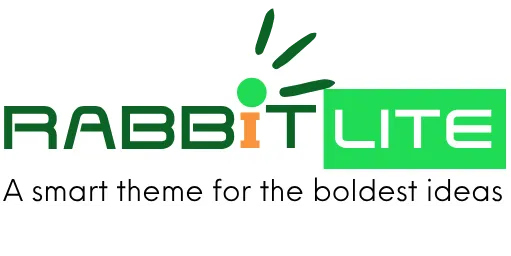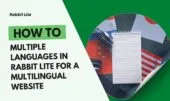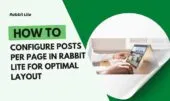- 1. Understanding Sidebar Widget Title Heading Tag
- 2. Default Heading Levels vs Custom Heading per Widget
- 3. Step-by-Step Guide to Configure Sidebar Widget Title Heading Tag
- 4. Best Practices for Sidebar Widget Headings
- 5. Common Mistakes to Avoid
- 6. Advanced Tips & SEO Optimization
- 7. FAQ
- 7.1. What heading tag should I use for sidebar widgets?
- 7.2. Which heading tag is most suitable for sidebar widget titles?
- 7.3. Can I set different heading tags for different widgets?
- 7.4. Does changing heading tags affect SEO?
- 8. Conclusion
Sidebar Widget Title Heading Tag is a crucial setting in Rabbit Lite that allows you to define the heading level for sidebar widget titles. Using this feature properly ensures better content hierarchy and accessibility for all users. When heading tags are configured correctly, SEO for sidebar widgets improves, and the layout remains visually organized.
Applying appropriate Sidebar Widget Title Heading Tag values also enhances usability and navigation for visitors. Selecting the right heading level creates a logical structure that search engines can easily interpret. This optimization directly supports higher search rankings and greater user engagement.
Optimizing sidebar widget headings with Sidebar Widget Title Heading Tag also supports accessibility standards. Screen readers can accurately announce widget titles, improving navigation for visually impaired users. Following this guide helps implement heading levels effectively and maximizes the benefits of Rabbit Lite sidebar headings.
Understanding Sidebar Widget Title Heading Tag
Sidebar Widget Title Heading Tag determines which HTML heading level is applied to widget titles, impacting both design consistency and SEO.
- You can select heading tags such as H2, H3, or H4, allowing each widget to follow a structured content hierarchy.
- This ensures a clear layout for users and helps search engines understand the importance of each widget.
- It improves accessibility by enabling screen readers to interpret widget titles correctly, making your site more inclusive.
- Applying consistent headings provides uniform styling across multiple widgets within the sidebar.
- For example, a recent posts widget might use H3, while a featured content widget could use H2 to emphasize hierarchy.
Default Heading Levels vs Custom Heading per Widget
Choosing the right default heading level or customizing per widget is important for sidebar design.
- Default heading levels maintain uniformity, giving all sidebar widgets a consistent appearance.
- Custom heading levels let specific widgets stand out, which can improve SEO and visual hierarchy.
- Default settings are simple and provide a consistent user experience across all widgets.
- Custom settings offer flexibility, emphasizing important content where necessary.
- You can apply these settings per widget in Rabbit Lite to suit different content types.
- Testing each configuration on both desktop and mobile ensures readability and accessibility.
Step-by-Step Guide to Configure Sidebar Widget Title Heading Tag
Follow these steps to configure Sidebar Widget Title Heading Tag effectively.
- Navigate to Rabbit Lite > Settings > Main Settings to access the heading tag options.
- Locate the Sidebar Widget Title Heading Tag section and select the widget you wish to configure.
- Choose the heading tag (H2, H3, H4) that best fits your content hierarchy.
- Save the changes and preview the widget on desktop and mobile devices.
- Adjust heading levels as needed to maintain logical hierarchy and accessibility.
- Regularly review these configurations to ensure they continue to meet your site’s content structure.
Best Practices for Sidebar Widget Headings
Proper heading selection ensures accessibility, SEO, and a clean design.
- Maintain a consistent heading hierarchy from H1 to H6 to avoid confusion.
- Follow accessibility standards so screen readers can interpret widget titles correctly.
- Use relevant keywords in widget headings to support SEO strategies.
- Avoid skipping heading levels to keep the content flow logical.
- Optimize headings for mobile devices to maintain readability on smaller screens.
- Audit widget headings regularly to keep the sidebar organized and functional.
Common Mistakes to Avoid
Avoid these errors when setting up Sidebar Widget Title Heading Tag.
- Using H1 for widget titles disrupts content hierarchy and SEO structure.
- Skipping heading levels can confuse users and search engines alike.
- Inconsistent heading tags across widgets reduce visual coherence.
- Ignoring accessibility makes navigation harder for screen reader users.
- Failing to test heading changes on multiple devices can lead to layout issues.
- Overlooking SEO impact by using redundant or irrelevant headings diminishes search performance.
Advanced Tips & SEO Optimization
Take your Sidebar Widget Title Heading Tag usage further with advanced strategies.
- Combine headings with structured data to improve SEO visibility.
- Monitor analytics to adjust widget heading levels based on user engagement.
- Maintain consistent heading strategies across the site for better UX.
- Highlight featured content with specific heading selections.
- Refine heading configurations regularly to align with SEO best practices.
- Test different heading arrangements to optimize sidebar readability and performance.
FAQ
Sidebar Widget Title Heading Tag frequently asked questions clarify common concerns.
What heading tag should I use for sidebar widgets?
Use H2 or H3 for most sidebar widgets, depending on page hierarchy. H2 suits main sidebar sections, while H3 or H4 is ideal for sub-widgets. Selecting appropriate tags improves SEO and ensures accessible navigation.
Which heading tag is most suitable for sidebar widget titles?
The most suitable heading tag typically depends on your page’s structure. H2 is recommended for main sidebar widgets, while H3 can be used for sub-widgets to maintain a logical hierarchy and SEO-friendly layout.
Can I set different heading tags for different widgets?
Yes, Rabbit Lite allows customizing heading levels for each widget. This emphasizes key content, improves visual hierarchy, and maintains accessibility. Always test across devices to verify layout and readability.
Does changing heading tags affect SEO?
Adjusting widget heading tags impacts content hierarchy and SEO. Properly structured headings help search engines understand content importance, enhancing rankings and providing a better user experience.
Conclusion
Optimizing Sidebar Widget Title Heading Tag ensures a clear content hierarchy, improves SEO, and supports user accessibility. Correct heading levels enhance readability, aid screen readers, and create a visually organized sidebar in Rabbit Lite.
Following best practices for Sidebar Widget Title Heading Tag ensures consistency, accessibility, and SEO optimization. Regular reviews and adjustments help maintain a professional and organized sidebar layout while maximizing the benefits of Rabbit Lite.









